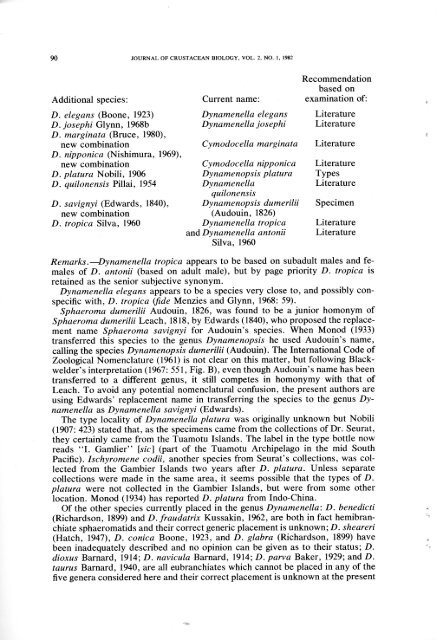Download PDF as one large file
Download PDF as one large file
Download PDF as one large file
Create successful ePaper yourself
Turn your PDF publications into a flip-book with our unique Google optimized e-Paper software.
90<br />
Additional species:<br />
D. elegans (Bo<strong>one</strong>, 1923)<br />
D. josephi Glynn, 1968b<br />
D. marginata (Bruce, 1980),<br />
new combination<br />
D. nipponica (Nishimura, 1969),<br />
new combination<br />
D. platura NobiH, 1906<br />
D. quil<strong>one</strong>nsis Filial, 1954<br />
D. savignyi (Edwards, 1840),<br />
new combination<br />
D. tropica Silva, 1960<br />
JOURNAL OF CRUSTACEAN BIOLOGY, VOL. 2, NO. 1, 1982<br />
Current name:<br />
Dynamenella elegans<br />
Dynamenella josephi<br />
Cymodocella marginata<br />
Cymodocella nipponica<br />
Dynamenopsis platura<br />
Dynamenella<br />
quil<strong>one</strong>nsis<br />
Dynamenopsis dumerilii<br />
(Audouin, 1826)<br />
Dynamenella tropica<br />
and Dynamenella antonii<br />
Silva, 1960<br />
Recommendation<br />
b<strong>as</strong>ed on<br />
examination of:<br />
Literature<br />
Literature<br />
Literature<br />
Literature<br />
Types<br />
Literature<br />
Specimen<br />
Literature<br />
Literature<br />
Remarks.^Dynamenella tropica appears to be b<strong>as</strong>ed on subadult males and females<br />
of D. antonii (b<strong>as</strong>ed on adult male), but by page priority D. tropica is<br />
retained <strong>as</strong> the senior subjective synonym.<br />
Dynamenella elegans appears to be a species very close to, and possibly conspecific<br />
with, D. tropica (fide Menzies and Glynn, 1968: 59).<br />
Sphaeroma dumerilii Audouin, 1826, w<strong>as</strong> found to be a junior homonym of<br />
Sphaeroma dumerilii Leach, 1818, by Edwards (1840), who proposed the replacement<br />
name Sphaeroma savignyi for Audouin's species. When Monod (1933)<br />
transferred this species to the genus Dynamenopsis he used Audouin's name,<br />
calling the species Dynamenopsis dumerilii (Audouin). The International Code of<br />
Zoological Nomenclature (1961) is not clear on this matter, but following Blackwelder's<br />
interpretation (1967: 551, Fig. B), even though Audouin's name h<strong>as</strong> been<br />
transferred to a different genus, it still competes in homonymy with that of<br />
Leach. To avoid any potential nomenclatural confusion, the present authors are<br />
using Edwards' replacement name in transferring the species to the genus Dynamenella<br />
<strong>as</strong> Dynamenella savignyi (Edwards).<br />
The type locality of Dynamenella platura w<strong>as</strong> originally unknown but Nobili<br />
(1907: 423) stated that, <strong>as</strong> the specimens came from the collections of Dr. Seurat,<br />
they certainly came from the Tuamotu Islands. The label in the type bottle now<br />
reads "I. Gamlier" [sic'\ (part of the Tuamotu Archipelago in the mid South<br />
Pacific). Ischyromene codii, another species from Seurat's collections, w<strong>as</strong> collected<br />
from the Gambler Islands two years after D. platura. Unless separate<br />
collections were made in the same area, it seems possible that the types of D.<br />
platura were not collected in the Gambler Islands, but were from some other<br />
location. Monod (1934) h<strong>as</strong> reported D. platura from Indo-China.<br />
Of the other species currently placed in the genus Dynamenella: D. benedicti<br />
(Richardson, 1899) and D.fraudatrix Kussakin, 1962, are both in fact hemibranchiate<br />
sphaeromatids and their correct generic placement is unknown; D. sheareri<br />
(Hatch, 1947), D. conica Bo<strong>one</strong>, 1923, and D. glabra (Richardson, 1899) have<br />
been inadequately described and no opinion can be given <strong>as</strong> to their status; D.<br />
dioxus Barnard, 1914; D. navicula Barnard, 1914; D. parva Baker, 1929; and D.<br />
taurus Barnard, 1940, are all eubranchiates which cannot be placed in any of the<br />
five genera considered here and their correct placement is unknown at the present

















